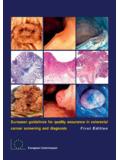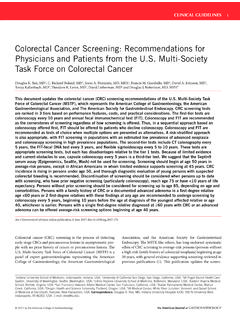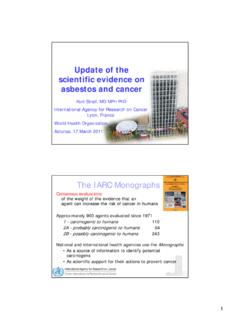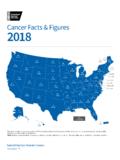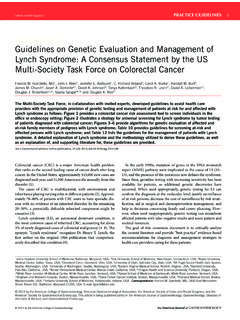Transcription of Colorectal Cancer Update 2017
1 Colorectal Cancer Update 2017 Dr. Barb Melosky Disclosure Research Bayer Honoraria/Advisory Board Roche, Amgen, Bayer, Lilly Objectives 1) Demonstrate knowledge of the epidemiology of Colorectal Cancer 2) Relate the importance of staging in treatment decisions 3) Summarize the management of adjuvant and metastatic therapies Definitions The Peritoneal Reflection Side also matters! RIGHT LEFT Colorectal Cancer Third most common Cancer in men and women alike Lifetime probability 1 in 17 BC Incidence Rates - Colorectal Cancer Females Males BC Women Survival with Colorectal Cancer BC Men Colorectal Cancer (CRC) Sporadic (average risk) (65% 85%) Family history (10% 30%) HNPCC (5%) FAP (1%) Rare syndromes (< ) Who is at risk? Males=Females Risk increases with age Average age at diagnosis is 67-70 yrs Industrialized nations Most cancers start as polyps - precancerous growths Fecal Immunochemical Test Colon Screening in BC Colon Check Pilot Program Funding from Ministry of Health in July 2008 Screening began in January 2009 in Penticton.
2 Powell River (September 2009) and Vancouver core (April 2010) Approximately 20,000 screened Provincial Colon Screening Program Announced in November 2012 by Ministry of Health FIT covered by MSP on April 1, 2013 Program rolled out in province wide November 15, 2014 Colon Screening Program Overview Target Population Men & Women age 50-74 Screening Test Patient obtains requisition for screening from health care provider Fecal immunochemical test (FIT) for average risk Screening colonoscopy for higher than average risk FIT Specimens are returned to the lab for processing and reporting Results Results mailed to both patient and health care provider Reminder Mailed to patient and health care provider when time to rescreen Colon Screening Policy Risk Screening Recommendation Average Risk Fecal immunochemical test (FIT) is recommended every two years for people who do not have a personal history of adenomas or a significant family history of colon Cancer .
3 Higher than Average Risk Colonoscopy is recommended every five years for people with at least one of the following: One first degree relative (mother, father, sister, brother, daughter or son) with colon Cancer diagnosed under the age of 60; or, Two or more first degree relatives with colon Cancer diagnosed at any age; or, A personal history of adenomas. Early Program Statistics 45% of eligible patients who have had a FIT have been registered Over 91,000 FITs have been completed through the program Over 22,000 patients have been referred to colonoscopy to investigate an abnormal FIT or for primary screening in higher risk individuals. Early Program Statistics Of the 1,483 patients with an abnormal FIT results that have had their colonoscopy and have pathology results available for review: 34% had a normal colonoscopy 16% had other pathology such as hyperplastic polyps 25% had low risk pre-cancerous polyps 24% had high risk pre-cancerous polyps 1% had Cancer .
4 Staging Staging 4 stages Stage I Cancer has grown thru the mucosa up to the muscular layer Stage II Cancer has spread into muscularis propria but not into lymph nodes Stage III Cancer has spread into lymph nodes but not to other parts of the body Stage IV Cancer has metastasized to distant organs 93 85 72 83 64 44 8 Percentage of Patients (%) 0 10 20 30 40 50 60 70 80 90 100 Stage I Stage IIA Stage IIB Stage IIIA Stage IIIB Stage IIIC Stage IV O Connell et al., 2004. (T3N0) (T1 2N0) (T4N0) (T1 2N1) (T3 4N1) (TanyN2) (M1) 5-Year Relative Survival By AJCC Stage National Comprehensive Cancer Network (NCCN), 2008; Greene et al., 2002. AJCC = American Joint Committee on Cancer . AJCCv6 TNM Staging Definitions Primary tumor (T) Tis Carcinoma in situ T1 Tumor invades submucosa T2 Tumor invades muscularis propria T3 Tumor invades through muscularis propria or subserosa T4 Tumor directly invades other organs or structures Regional lymph nodes (N) N0 No regional lymph node metastases N1 Metastases in 1 3 regional lymph nodes N2 Metastases in 4 or more regional lymph nodes Distant metastases (M) M0 No distant metastases M1 Distant metastases T4a: perf.
5 Visceral peritoneum T4b: invasion of organs N1a: 1 N+ N1b: 2-3 N+ N2a: 4-6 N+ N2b: >7 N+ AJCC v7 Effective Jan 2010 AJCC v7 Gunderson et al, JCO 2009 Stage II Stage III AJCC v7 Gunderson et al, JCO 2009 Stage II Stage III Adjuvant Treatment for Colon Cancer stage II stage IV stage I stage III CRC Demographics and Presentation The Evolution of Adjuvant Therapy 1990 5-FU/Levamisole 12 months >observation. 1994 5-FU/LV 12 months > than observation 1998 5-FU/LV > than 5-FU/Levamisole. 1998 6 months = 12 months. 2003 FOLFOX > 5FU/LV 2004 Capecitabine = 5FU/LV. 2005 No role for Irinotecan confirmed. 2009 CAPOX better that 5FU/LV 2010 Role of biological agents negative Avastin /Cetuximab Intergroup 0035 Stage III Colon n = 930 5-FU + Levamisole No Adjuvant Rx 52 weeks Moertel N Engl J Med 1990 Levamisole Moertel, C.
6 G. et. al. Ann Intern Med 1995;122:321-326 Intergroup 0035 OS 16% absolute reduction BCCA Adjuvant Chemotherapy Stage lll: N1+ FOLFOX / CAPOX Capecitabine: Elderly or Unfit Stage ll High Risk T4: FOLFOX Low Risk: Capecitabine If treatment deemed necessary / Rule out MSI MOSAIC: Study Design n=2246 Completely resected colon Cancer Stage II, 40%; Stage III, 60% R LV5FU2 FOLFOX4 (LV5FU2 + oxaliplatin 85 mg/m ) (n=1123) (n=1123) MOSAIC 6-yr DFS: ASCO 2007 Disease-free survival (months) FOLFOX4 LV5FU2 Probability 0 0 6 12 18 24 60 30 36 42 48 54 Events FOLFOX4 304/1123 ( ) LV5FU2 360/1123 ( ) HR [95% CI]: [ ] p= Disease-free Survival: Stage II and Stage III Patients HR [95% CI] p-value Stage II [ ] Stage III [ ] FOLFOX4 stage II LV5FU2 stage II FOLFOX4 stage III LV5FU2 stage III Months Probability 0 0 6 12 18 24 60 30 36 42 48 54 66 72 p= p= XELOXA Trial HR= (95% CI.)
7 P= 0 1 2 3 4 5 6 Years CAPOX 5-FU/LV CAPOX (6 months) capecitabine 1000mg/m2 bid d1 14 oxaliplatin130mg/m2 d1 BCCA Adjuvant Chemotherapy Stage lll: N1+ FOLFOX/ CAPOX Capecitabine: Elderly or Unfit Stage ll High Risk T4: FOLFOX Low Risk: Capecitabine if treatment deemed necessary (R/O MSI) X-ACT: Unfit CAPECITABINE 1 250mg/m2 BID, d1 14, q21d BCCA Adjuvant Chemotherapy Stage lll: N1+ FOLFOX CAPOX (XELOX): Funding October 1 2011 Capecitabine: Elderly or Unfit Stage ll High Risk T4: FOLFOX Low Risk: Capecitabine if treatment deemed necessary (R/O MSI) MOSAIC: DFS High-risk Stage II Disease-free survival (months) FOLFOX4 n=286 LV5FU2 n=290 Probability 0 0 6 12 18 24 60 30 36 42 48 54 66 72 HR: ; (CI): ASCO criteria T4 tumour with adherence to or invasion of local organs Bowel obstruction at presentation Perforation at tumour site Poorly differentiated tumour histology Peritumoural lymphovascular involvement Questionable surgical margin <12 nodes examined Microsatelite Instability - Colon Cancer Tumors: Poorly differentiated, Signet-ring-cell, Lymphocytic infiltration, near diploid Right sided, Female, Early stage, Better prognosis Malignant cells resistant to 5-FU1,2 1 Carethers, 1999; 2 Arnold 2003 Overall Survival stage II MSI Treatment 5FU HR: ( ) p= N = 55 N = 47 Untreated 93% Treated 75% 5 yr OS What happened to the biologics?
8 EGFR Monoclonal Antibodies Panitumumab, Cetuximab VEGF Monoclonal Antibodies Bevacizumab ALL NEGATIVE !!! Future in Adjuvant? New drugs? IDEA International Duration Evaluation in Adjuvant Worldwide effort to address Duration 6 vs 3 months R 3 mos 6 mos Group-specific question +/- BEV +/- Celecoxib +/- Agents X/Y/Z FOLFOX or XELOX Adjuvant Treatment for Rectal Cancer Radiation and Surgery 1970s 1980s 1990s 2000s Surgery vs Radiation and Surgery 5 Y OS 62 vs 63% Pre-op 46% reduced LRR Post-op 37% reduced LRR Total Mesorectal Excision established as the superior surgery 2001: Radiation reduces Loco Regional Relapse (LRR) even when TME is done. CCCG Lancet 2001; Kapitejn NEJM 2001 Radiation Preoperative preferred: Short or Long Course Short: The tumour doesn t need to be smaller 5 days treatment followed within a week by surgery.
9 Chemotherapy after if necessary Long: The tumour needs to be made smaller before surgery: 5 radiation treatments/week for 5 weeks with capecitabine followed 4-6 weeks later by surgery Chemotherapy after if necessary Rectal Cancer : Short Course XRT Radiation 1 week 1 week Surgery 6-8 weeks Chemo N: Pathology N1 FOLFOX 6 months N0 Cape 6 months Rectal Cancer : Long Course Chemo-radiation 5 weeks 6 weeks Surgery 6-8 weeks Chemo N: Imaging N1 FOLFOX 4 months N0 Cape 4 months Surveillance CEA every 3 months for 3 yrs and then every 6 months for another 2 yrs = 5 years Imaging chest abdomen and pelvis yearly for 5 years Why?.. Liver/ lung lesions may be cured with surgery Regional Treatment Strategies 5 year survival 30-35% following resection of oligo- hepatic metastases Metastatic Colorectal Carcinoma Lines of Therapy Today BCCA First Line FOLFIRI + Bevacizumab Capecitabine PS 2 Second Line FOLFOX Third Line Ras WT: Panitumumab or Cetuximab Nature, March 30, 1957 5FU the Drug of Choice for over 60 Years!
10 First Line FOLFOX or FOLFIRI? Why add the bevacizumab? IFL and Avastin: OS HR= (95% CI: ) p< 0 10 20 30 40 Months IFL + Avastin IFL + placebo ITT population Hurwitz et al. NEJM 2004 Estimated probability 66 PFS 0 5 10 15 20 25 Months PFS estimate HR = [ CI ] (ITT) p = 0 FOLFOX+placebo/XELOX+placebo N=701; 547 events FOLFOX+bevacizumab/XELOX+bevacizumab N=699; 513 events Saltz et al., JCO 2008 How long do you treat for in first line? Drug Holidays or Treatment to Progression? OPTIMOX 2 6 FOLFOX FOLFOX 5FU/LV 6 FOLFOX FOLFOX Maindrault-Goebel et al, ASCO 2006 0 1 0 2 0 3 0 4 0 5 0 0 . 0 0 . 2 0 . 4 0 . 6 0 . 8 1 . 0 26 months 19 months Maintenance CFI P = Maindrault-Goebel et al, ASCO 2007 months OPTIMOX 2: OS Lesson from OPTIMOX2: Complete chemo free intervals may not be ideal OS 7 months Second Line?











